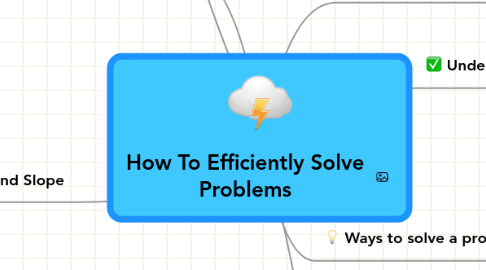How To Efficiently Solve Problems
da Christie Boeve


1. Reasoning
1.1. Deductive reasoning: obtaining a conclusion from given information
1.2. "If...Then" formatting
1.2.1. Hypothesis: If a number is less than 3, (this is our given information) The it is less than 8. (this is our conclusion drawn from the given information)
2. Linear Functions and Slope
2.1. Functions whose graphs are lines that are not parallel to the vertical axis are called Linear Functions
2.2. Graphs can be helpful in solving a problem when two variables are related in some way, or problems with time, money or speed.
2.3. There are two types of slope: Positive and Negative. Positive slope is when the lines extend from lower left to upper right and negative is the opposite, when the line extends from the upper left to the lower right of the graph.
2.4. y=mx+b is said to be slope-intercept form, because the slope (m) of the line and the Y intercept (b) can be read from the equation.
3. What is a problem?
3.1. A problem is a question that has no obvious solution
4. Using Venn-diagrams
4.1. Venn-diagrams can be useful when comparing and contrasting two or more things
4.1.1. A Venn-diagram is a set of two or more over lapping circles. they are each labeled and similarities go in the middle where the circles overlap and if the object does not match both categories it is put in the correct circle, but not in the middle.
5. Understanding the problem
5.1. read and reread
5.2. draw/sketch a diagram
5.3. restate the problem in your own words
5.4. make an educated guess
6. Ways to solve a problem
6.1. devise a plan
6.1.1. carry out the plan
6.1.1.1. look back
